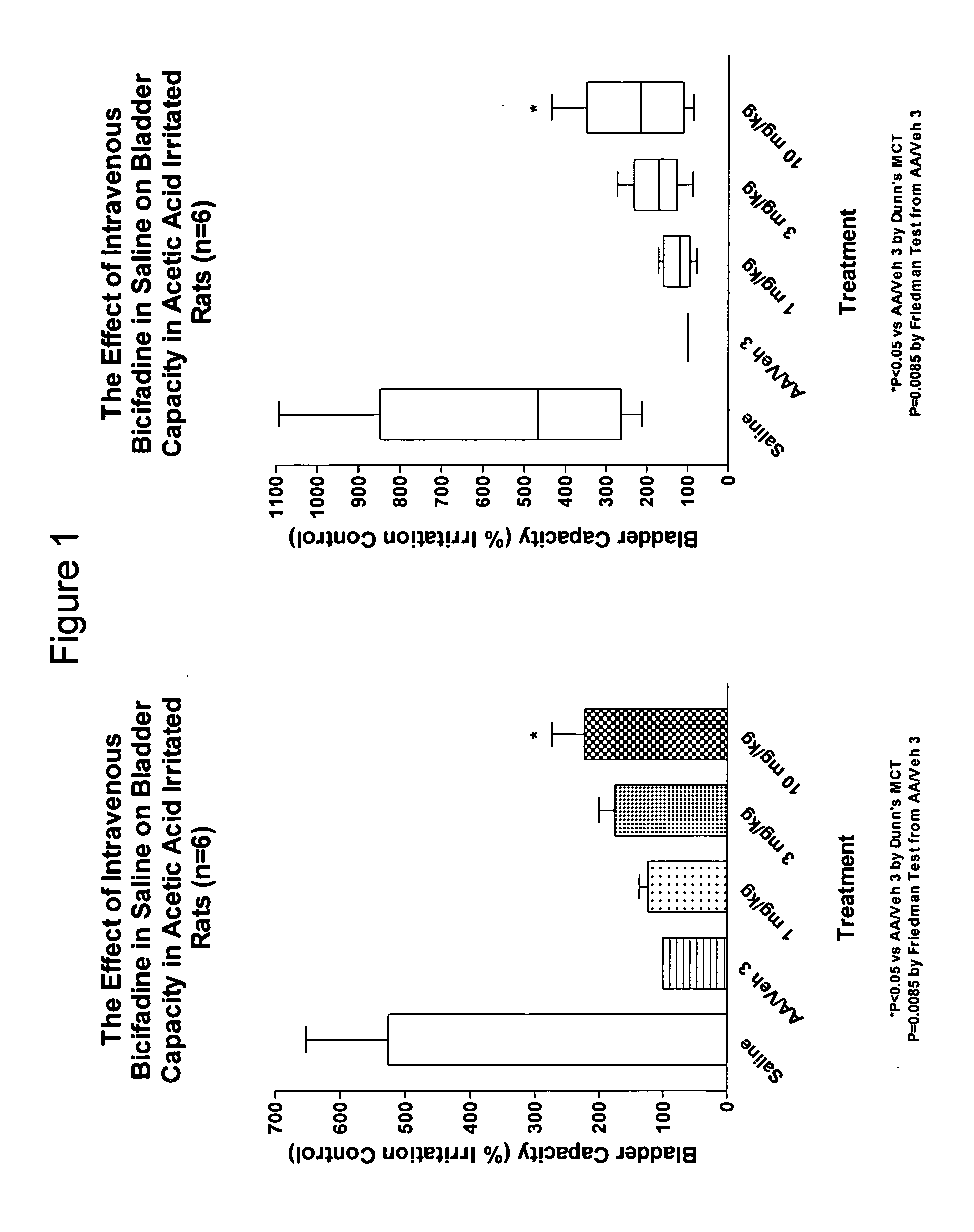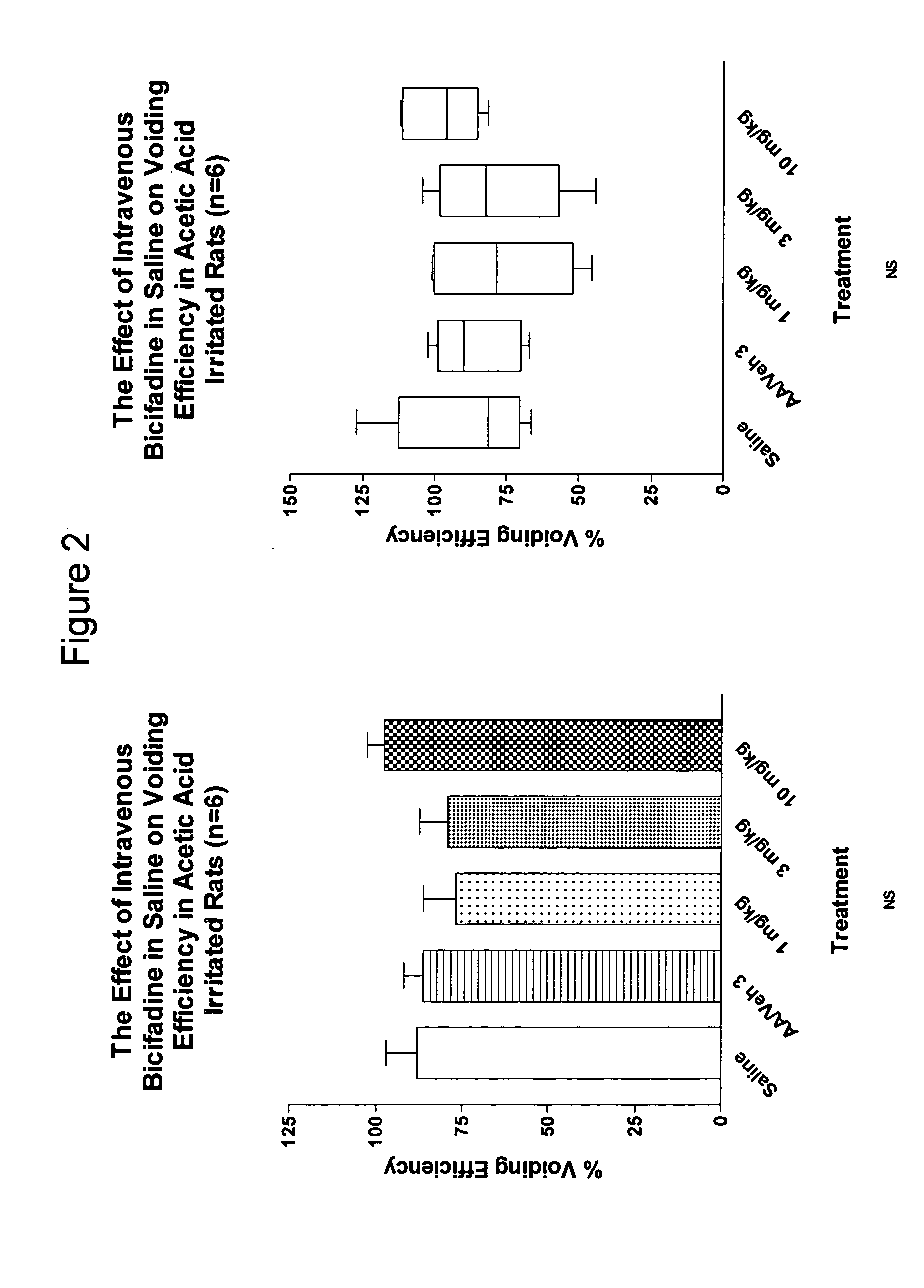Dual acting SNRI-NMDA antagonists for the treatment of genitourinary disorders
a genitourinary disorder and snri-nmda technology, applied in the field of dual-acting snri-nmda antagonists for the treatment of genitourinary disorders, can solve the problems of not effectively reducing the activity of norepinephrine and serotonergic neurons, and achieve the effect of enhancing the effect of therapy
- Summary
- Abstract
- Description
- Claims
- Application Information
AI Technical Summary
Benefits of technology
Problems solved by technology
Method used
Image
Examples
example 1
Acute Rat Models: Dilute Acetic Acid Model and Protamine Sulfate / Physiological Urinary Potassium Model
[0470] The acute models described below provide methods for evaluating active agents in the treatment of overactive bladder. Briefly, the models provide a method for reducing the bladder capacity of test animals by infusing either protamine sulfate and potassium chloride (See, Chuang, Y. C. et al., Urology 61(3): 664-670 (2003)) or dilute acetic acid (See, Thor, K. and Katofiasc., M., 1995, J. Pharmacol. Exptl. Ther., 274:1014-1024; Sasaki, K. et al, J. Urol. 168(3) 1259-1264 (2002)) into the bladder.
[0471] The infusates cause irritation of the bladder and a reduction in bladder capacity by selectively activating bladder afferent fibers, such as C-fiber afferents. Following irritation of the bladder, an active agent (drug) can be administered and the ability of the active agent to reverse (partially or totally) the reduction in bladder capacity resulting from the irritation, can b...
example 2
A Cute Cat Models: Dilute Acetic Acid Model
[0480] The ability of bicifadine and milnacipran, exemplary dual acting SNRI-NMDA antagonists, to reverse the reduction in bladder capacity observed following continuous infusion of dilute acetic acid in a cat model was tested. The cat model is a commonly used model for overactive bladder (Thor and Katofiasc, 1995, J. Pharmacol. Exptl. Ther. 274: 1014-24).
Animal Preparation:
[0481] Female cats (2.2-3 kg B W Harlan) were anesthetized with 4% isoflurane for induction followed by intravenous administration of α-chloralose (68-75 mg / kg). An i.v. catheter was inserted in the radial vein for drug administration. A heparinized (100 units / ml) saline-filled catheter (PE-90) was inserted into the carotid artery to monitor blood pressure. A trachea tube was place to monitor respiration. Via a midline lower abdominal incision, a modified 16 gauge i.v. catheter was inserted into the bladder dome for bladder filling and pressure recording. The abdomin...
PUM
| Property | Measurement | Unit |
|---|---|---|
| time period | aaaaa | aaaaa |
| time period | aaaaa | aaaaa |
| time period | aaaaa | aaaaa |
Abstract
Description
Claims
Application Information
 Login to View More
Login to View More - R&D
- Intellectual Property
- Life Sciences
- Materials
- Tech Scout
- Unparalleled Data Quality
- Higher Quality Content
- 60% Fewer Hallucinations
Browse by: Latest US Patents, China's latest patents, Technical Efficacy Thesaurus, Application Domain, Technology Topic, Popular Technical Reports.
© 2025 PatSnap. All rights reserved.Legal|Privacy policy|Modern Slavery Act Transparency Statement|Sitemap|About US| Contact US: help@patsnap.com



